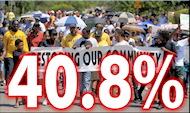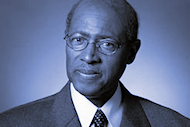The Right to Vote: The Core of Our Representative Democracy
Report from John Payton; President and Director-Counsel of the NAACP Legal Defense Fund to the The United Nations Forum on Minority Issues
The NAACP Legal Defense and Educational Fund is the oldest – and has been described as the finest – human rights law firm in American history. We have been involved in virtually all of the modern efforts to effectuate effective political participation by African Americans.
For most of U.S. history Black Americans were excluded from political participation. I will describe the means by which that exclusion was achieved and the continuing efforts to counteract those measures.
But, first, I will describe the election process in the U.S. There is no national election authority or commission in the U.S. Instead, elections are run by our separate states, and, in those states the elections are run by smaller local entities, usually counties. So, there were thousands of different ballots for last November’s election, all processed in different ways.
Additionally, in the United States individual candidates run for individual offices. There are political parties, but there are no party lists or proportional representation. Instead, there is a geographically defined district. Some are fixed, as are state wide offices or the President. But most are drawn on a map from time to time.
Each of these points – who runs the election, who draws the district -- can be affected by discrimination.
The United States is a democracy with a written constitution, but that original Constitution condoned and accommodated racism and slavery, and, even after our civil war ended slavery and resulted in amendments to our constitution that provided for equal justice, those very same local entities – states and their subdivisions, effectively thwarted change.
There were two types of exclusionary measures. Voter registration was the first and was implemented in the South for the purpose of creating a mechanism of exclusion. Here is how it would work: in order to be registered a potential voter would have to demonstrate that he or she was literate. That requirement would be waived by the registration official for white potential voters and used to deny Black potential voters. There were innumerable variations on the ways in which this device was used to exclude Blacks.
And second, the operation of the election itself could be infused with discrimination. Where were the polling places located? Were they moved the evening before the election? Were there enough ballots? Did they open on time? There are endless variations on this as well.
These measures were used effectively and excluded Black and other minorities from participation.
The Legal Defense Fund was founded in part to attack this racist reality. We challenged each of the practices I have described – registration requirements, poll taxes, literacy tests, how elections were operated. Eventually we were joined by the Federal Justice Department in challenging these discriminatory measures. But even when we were successful, the local jurisdiction would simply move to another variation of the same scheme and achieve the same result -- via a new literacy test, or moving a polling place in the Black community just before the election. Legal remedies were not effective because a new device could be put in place as soon as an earlier one was invalidated.
The Voting Rights Act of 1965
The Voting Rights Act of 1965 is the principal measure in combating this racial discrimination. It is the single most effective piece of civil rights legislation in the U.S. The Voting Rights Act bans discrimination in voting on the basis of race or national origin and gives the federal government wide authority to ensure non-discrimination in voting. In addition, and crucially, Section Five of the Act serves as a checkpoint by requiring jurisdictions within the U.S. that have a history of discrimination in voting to obtain approval from the federal government before enacting any changes to their voting practices or procedures, a process known as “preclearance.” Thus, Section Five acts like a national election commission in some ways. Preclearance has been an extremely effective tool in rooting out and deterring acts of discrimination in voting. Since 1982 it has prevented the enactment of over 600 documented discriminatory changes to voting laws. This critical law, the Voting Rights Act, was challenged in our Supreme Court this year, and we, the Legal Defense Fund, argued in the Supreme Court and succeeded in preventing it being declared unconstitutional.
The Census: Accurately Counting Minorities
Census data is used to determine the number of seats that each state will have in the House of Representatives, and the number of votes that each state has in the Electoral College, which is how the President of the United States is selected. Census data is also used in the drawing of election districts, and in making sure that election districts are roughly equal in size. The enforcement of the Voting Rights Act of 1965, which I described previously, also depends heavily on accurate Census data.
Redistricting
After the Census results are finalized, the various States throughout the country engage in the process of redistricting, or redrawing electoral districts for political offices, from school boards to city councils, state legislatures to the U.S. Congress. How and where those lines are drawn often determines whether or not members of minority groups will have the ability to participate meaningfully in the political process and elect candidates of their choice. Historically, however, the redistricting process has frequently excluded members of minority groups. Until the 1990’s, the redistricting process remained largely under the control of voting blocs and power structures that did not consider – or even purposefully undermined – the interests of racial and ethnic minorities. During redistricting, racial minorities were often spread out amongst many districts so as to dilute their voting strength, or, in other cases, packed as a supermajority into a single district so as to limit their ability to participate in and win elections in other districts.
However, thanks to vigorous enforcement of the Voting Rights Act in the redistricting process, the number of minority representatives in the U.S. Congress has increased from 40 in 1990 to 70 today. In other words, it is no exaggeration to say that the redistricting process may be the single most important factor in determining whether racial and ethnic minorities have a meaningful opportunity to participate in the political process and elect their candidates of choice.
In sum, the right to vote is at the core of our representative democracy. It is not only a human and civil right in itself; it is the bedrock on which all other rights rest. The ability of members of racial and ethnic minority groups to meaningfully participate in the political process is a crucial measure of our nation’s commitment to democracy and equality under the law.











